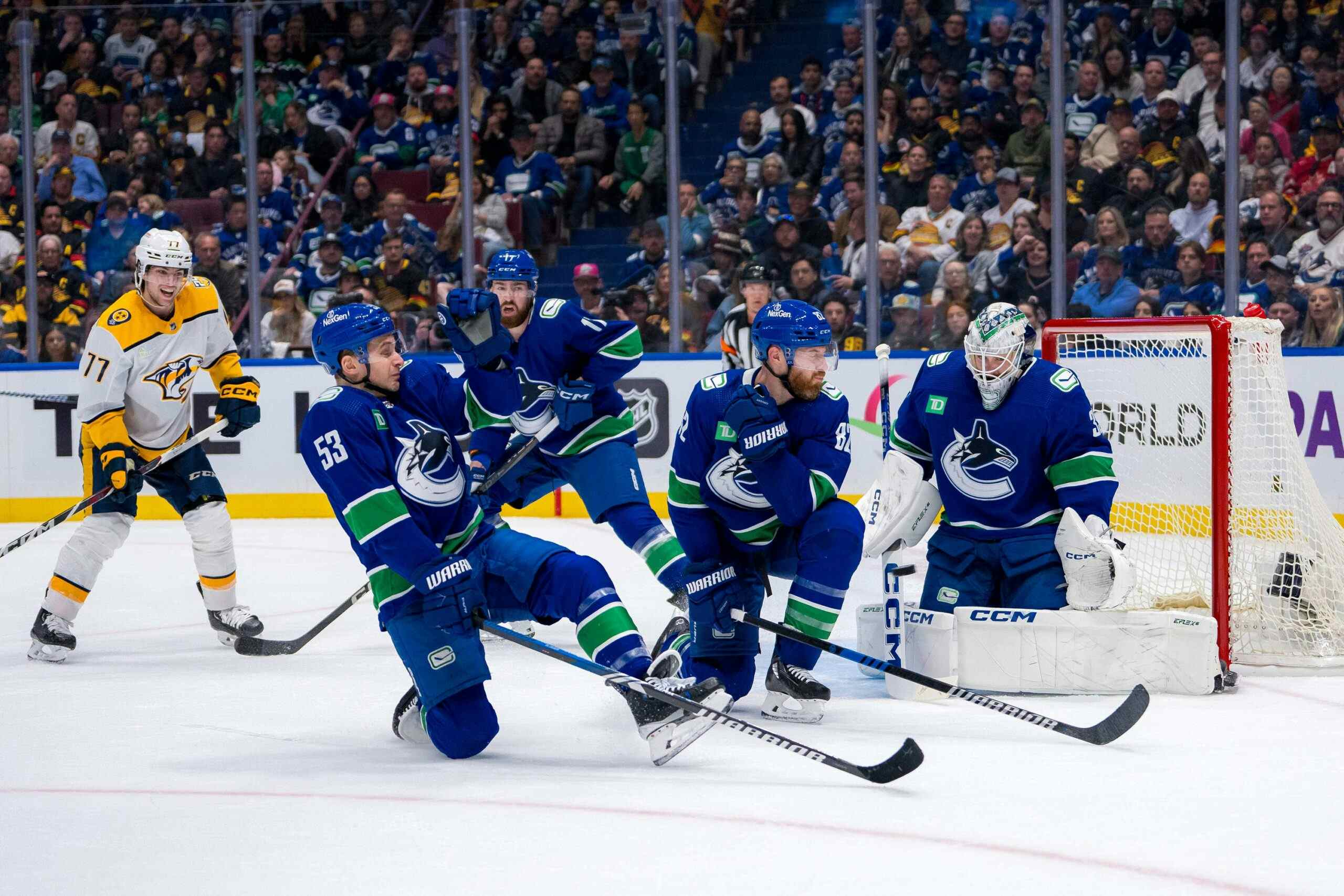Canucks’ Free Agent Additions Shouldn’t Move the Needle in Terms of Playoff Competiveness – Or the Draft Lottery
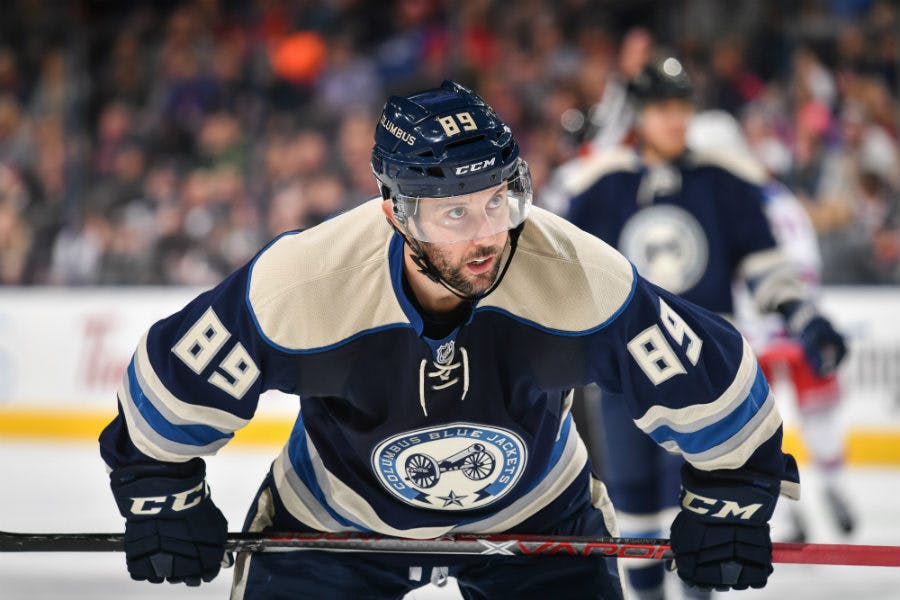
By Jeremy Davis
6 years agoThe Canucks made a big splash in free agency this year, and not in comes-back-to-bite-you-in-the-ass kind of way (you know, like they did in 2016). Rather, they went for depth and volume, plugging holes that needed plugging without giving too much away in either term or annual value.
In other words, they did a pretty good job, which is why Jackson gave them the reasonably high grade of a B+.
But as you may have noticed (or you can see in the article linked above), many others are not as pleased with Benning’s additions. I won’t rehash the objections that were mentioned in Jackson’s article, since, as he said, they’ve come mostly from national outlets who don’t pay close enough attention to understand the difference between plugging holes and trying to make the playoffs.
But that type of reaction hasn’t been strictly from the outside. Some of our local, more level-headed media members have pondered the same thing.
There exists a portion that here are concerned that the Canuck’s free agent additions would push them into hockey’s version of purgatory, where a team isn’t good enough to make the playoffs or bad enough to guarantee a top five pick. (Heck, in this day and age, unless you’re good enough to get out of the first round, you’re basically considered to be stuck in that boat as well).
We know that Canucks aren’t a real playoff team, and the worry now is that they’ll be too good and will work themselves out of a decent lottery position, which is especially damning in a year with some real top end talent in the draft, including a defencemen who objectively could be the best to come along since Erik Karlsson. The Canucks could use a player like that. Anyone could really, so I get the objection about getting “too good”.
What I don’t think these people understand is a) just how bad the Canucks were in the second half of last season, and b) how devoid their lineup was of NHL talent.
The Canucks may have finished as the second worst team in the league on the back of an atrocious second half, but that doesn’t mean they were any good to start with. On January 1st, their 37 points ranked sixth worst in the NHL. They were already 38 games into the season, possessing a minus-20 goal differential, long before Markus Granlund or Brendan Gaunce ended their seasons for surgery, and having Erik Gudbranson for three-quarters of their games. By mid-February, they’d dropped a spot in the standings, and by the time the trade deadline rolled around, they’d dropped another. Only then did the team deal Alex Burrows and Jannik Hansen (who, in fairness, had missed a lot of the season anyway) and the Canucks really began to plummet.
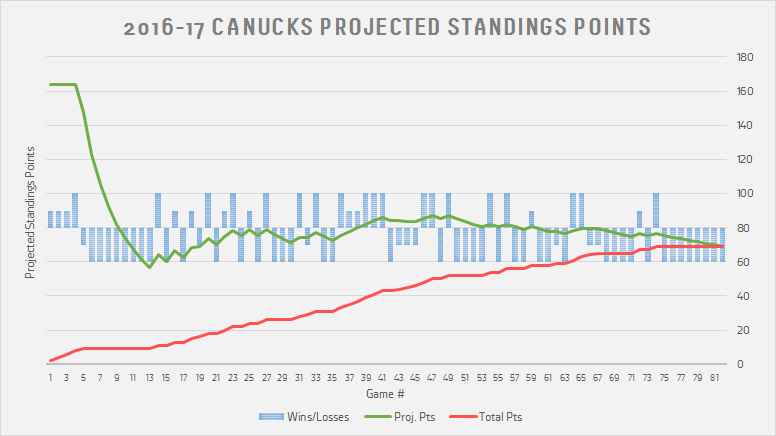
By the end of the season, the Canucks’ roster was a disaster, missing eight of the 18 players that they dressed on opening night. Now five of those were due to injury, and one was simply in the minors (Jake Virtanen), meaning the Canucks will have most of those players back next year. But they’ll also be without three of player that did play in that game, as Nikita Tryamkin and Philip Larsen left for Russia after the season and Luca Sbisa was claimed by Vegas in the expansion draft.
I’ve taken the liberty of fishing up the values of the incoming and outgoing players, to see how the prospective 2017-18 squad compares against the one that was quite accurately projected (by some outlets) to tally 65-70 standings points last season.
Skaters
Using DTMAboutHeart’s Goals Above Replacement metric, I’ve plotted the approximate value above replacement that the Canucks have lost from their roster since last season. As a heads up, these are the 2016-17 accumulated GAR values for each player, rather than per game rates.

Alex Burrows leads the way, with a value of 4.3 Goals Above Replacement. Burrows had the ninth highest GAR among players that suited up for the Canucks last season, making his exit a pretty significant blow. Ditto for Jannik Hansen, whose 2.9 GAR ranked 13th on the Canucks. Luca Sbisa and Nikita Tryamkin also make noticeable losses.
Of interest here is Sbisa and Tryamkin’s GAR relative to each other: while Tryamkin’s even strength offence and defence is vastly superior to Sbisa’s, Tryamkin was sunk for how many penalties he took, while Sbisa’s discipline was a large boon for him.
Altogether, the outgoing Canucks listed here add up to 9.8 Goals Above Replacement.
Now let’s take a look at the players that the Canucks brought it as free agents.
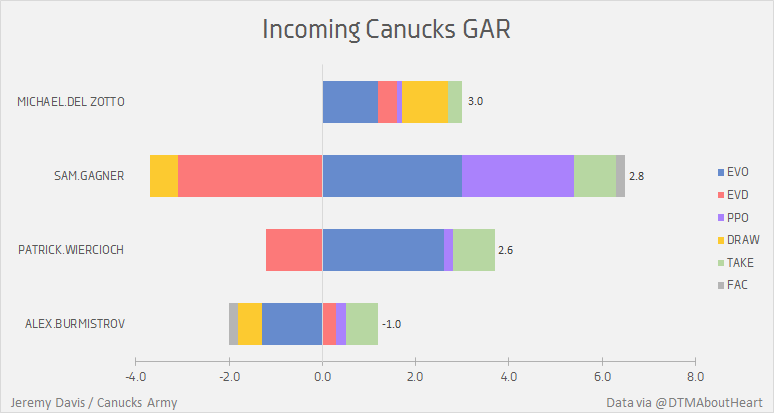
We’ve heard plenty about Gagner’s struggles defensively, and GAR has certainly picked up on that. Luckily, Gagner’s power play prowess last year saved him and turned him into a valuable asset. Still, no one here brings the value that Burrows did, though Del Zotto and Gagner are both just about on par with Hansen’s value.
The incoming Canucks players listed here have a total GAR of 7.4, which is noticeably lower than the outgoing value. Here they are compared against one another:

From this perspective, it seems as though the Canucks have taken a big hit to their even strength defence in exchange for power play offence and discipline. The overarching point is though that the incoming value, according to this particular metric, doesn’t even cover the value that was lost.
Goalies
We haven’t even mentioned yet the loss of Ryan Miller and addition of Anders Nilsson. GAR doesn’t evaluate goaltenders, but we’ll touch on that quickly using Ian Fleming’s SAVE chart, this one plotting their numbers of the previous three seasons.
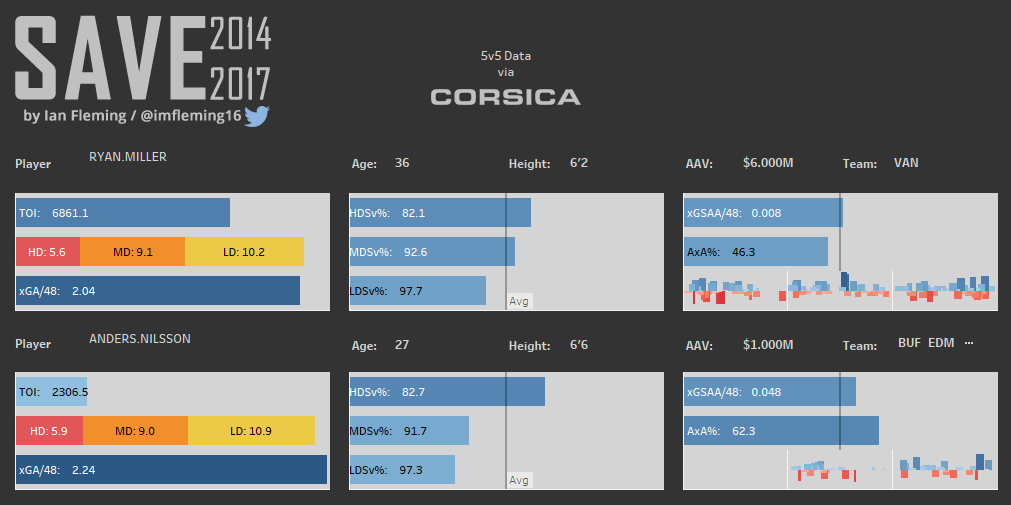
A couple of takeaways: Miller has played a whole lot more, which isn’t surprising – he’s been a number one goaltender for all three seasons, while Nilsson has been a backup and only played in the last two – although he had a more prominent role last season in Buffalo with Robin Lehner battling injuries.
Nilsson’s High Danger Save Percentage has been higher than Miller’s, but his Low-Danger and Medium-Danger Sv%’s have been below league average. However, they were much better in 2016-17 than they were in 2015-16, and Nilsson is at the age where we can feel comfortable with year-to-year improvements being termed as development rather than anomalies.
All in all, we’d expect Nilsson to be a decent replacement for Miller, as he’s put up comparable numbers, albeit with a lighter workload. Of course, one could make the argument that Markstrom is replacing Miller and Nilsson is actually replacing Markstrom. In that case, it’s difficult to predict how each will perform. Data compiled for a save rate versus workload analysis I did on Ryan Miller during the season suggested that Markstrom’s save rates increased when his workload increased (the opposite of Miller’s). If that proved to be the case, he may prove to be as good as Miller was for the Canucks last season.
Confounding Factors
As objective as we’re trying to be, this article is still fairly simplistic in its analysis, as we’re only taking into account the value of incoming and outgoing players. For the most part we haven’t concerned ourselves with the change in value provided for returning players who roles with increase or decrease, such as Michael Chaput and Jayson Megna, who I’d expect to be waived and sent to Utica, or full seasons of Brock Boeser, Reid Boucher, and Anton Rodin. There’s also the returns of Derek Dorsett and Erik Gudbranson to consider, and given their past values, increased ice time may be more of a detriment than a benefit.
And of course there are injuries. Every year, the Canucks are hampered by a multitude of injuries that destroy value by taken players out of the lineup, or diminish value by having players play through injuries (e.g, 2015-16 Henrik Sedin or 2016-17 Chris Tanev). The last couple of seasons have been particular bad for this, and next season could end up being very similar.
Conclusion
Individual and team success in sports is incredibly difficult to predict with any high degree of certainty. We know which teams are in the upper, middle, and lower echelons, but pinpointing positions in the standings well before seasons get underway is often a fruitless endeavor. Evaluating historical results can give us a little bit of perspective, but for the most part there is a lot of guess work, and a whole lot of factors that are well beyond our control.
What we know is that this is still not a particularly good team. This is a team that not only finished 29th in the NHL last season, but they did so in extravagant fashion by plummeting downwards in the second half of the season. What has happened here in the off season hasn’t remade this into a bubble team. It’s plugged some holes in the lineup and restored it to a roster that is similar to the one that the Canucks began the 2016-17 season with – back when they were expected to finish at the bottom of the league anyway. They’ve plastered some duct tape over the hole in the hull of the Titanic and rearranged the deck chairs up top, but the expected result shouldn’t be all that different.
And that’s okay!
This is what many of us in this market wanted. This is a team that is going to go into the year with low expectations, finish low in the standings, and come away with another high draft pick – draft lottery Gods willing, most likely in the top five again. What’s more is that the Canucks aren’t selling it as anything more than that. Sure, they won’t tell you they’re shooting for a bottom five finish, but you won’t hear anything about shooting for the playoffs either. They want to stay “competitive”, a necessarily ambiguous word that really means a desire to not be blown out in games. Losing games 4-2 or 7-1 means the same thing in the standings, but they mean very different things psychologically, especially to younger players (of which there should be plenty in the lineup).
The Canucks are definitely different than last off season, but in no certain terms are they better. The most likely outcome is one similar to last year, but it will of course be highly subject to luck and chance. Worries that they’ll fall out of the draft lottery picture and too far into hockey purgatory are, in my opinion, entirely premature. The Rebuild (with a capital ‘R’!) is still chugging along.
Recent articles from Jeremy Davis



